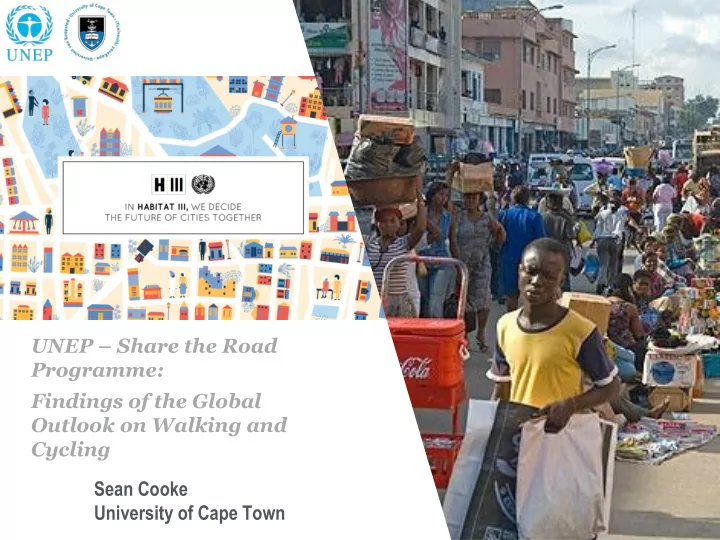

UNEP – Share the Road Programme: Findings of the Global Outlook on Walking and Cycling Sean Cooke University of Cape Town
01 INTRODUCTION
• Why do countries need NMT policies or commitments? • What makes a good NMT policy? • Is there a correlation between policies and NMT safety?
4 OUR STUDY • Our focus – developing and emerging countries • Mode shares of up to 80% NMT • Marginal NMT recognition - whether in policy and legislation, or in budget, resource and space allocation • Worst global road safety record • Pedestrians and cyclists most at risk
5 KEY QUESTIONS • What is the level of NMT commitment within the countries surveyed? • How comprehensive are these NMT commitments? • Are NMT users safer in countries with high levels of NMT commitments? • Is there a link between countries with significant NMT commitment and countries undergoing BRT / public transport transformation in any way?
02 RESEARCH METHOD
7 OUR METHOD • Literature review - what makes a good NMT policy? • Interviews / online survey – mailed to around 200 selected (and snowball sampled) people; plus expert input and additional research • Questions geared to asses NMT Commitment plus NMT performance (mode share, safety, etc)
8 What is an NMT commitment? A course or principle of action adopted or proposed by a government, party, business, or individual. Synonyms: plans, strategy, approach, system, guidelines…
03 PRELIMINARY FINDINGS
10 Overall , countries have made a start There is national recognition of NMT as a mode.
Depth of commitment • Broad, general statements (eg putting people first) • Most of the countries have devolved some NMT planning and commitments down to the local or metropolitan level
Public transport • Public transport improvement, transformation or restructuring programmes appear to play an important role in raising awareness within government about the value of NMT (as cost-effective feeder modes, for eg) and at times offer a vehicle for infrastructure funding. Bicycle infrastructure • Most countries do not evaluate or re-asses facilities. • Every country that has done so (university or funder request), found them to be poor quality, in the wrong place, dangerous or in some way lacking.
Monitoring, evaluation & reporting • Poor monitoring, verification, evaluation • Few able to quantify, measure or track goals or ‘promises’ • Mostly measure outputs, not outcomes and impacts
Substantive data gaps • Little comparable data Few respondents able to provide: • Analysis of user needs • Database of infrastructure • Risk ratio, motorization, trip rates, etc Action strategies • Few policies translated into action-oriented, measurable strategies • Few cities plan beyond infrastructure to the nuances of behaviour change.
04 NMT INDEX
16 PERFORMANCE VS COMMITMENT INDEX INDEX based on the development of two indices that measure NMT commitment, and NMT performance The matrix shows four quadrants within which each country is positioned: 4. Weak NMT performance (safety), strong policy commitment 3. Weak NMT performance (safety), weak policy commitment 2. Strong NMT performance (safety), weak policy commitment 1. Strong NMT performance (safety), strong policy commitment
17
04 CONCLUSION
19 ANSWERS (1) … What is the level of NMT commitment within the countries surveyed • Every country has some national commitment – of varying degrees, some simply a few paragraphs in a national transport policy, some, a standalone policy How comprehensive are these NMT commitments? • Few are comprehensive enough, and few include measurable and verifiable goals, objectives and action plans to which the authority is held accountable
20 ANSWERS (2) … Are NMT users safer in countries with high levels of NMT commitments? Not yet, not as far as our data shows – largely because: • Insufficiently nuanced data • NMT commitments are relatively new • NMT commitments are too broad, insufficiently measurable, or not yet at local level Is there a link between countries with significant NMT commitment and countries undergoing BRT / public transport transformation in any way? • Seems so, yes…
21 NEXT STEPS Develop the Outlook on Walking and Cycling into an annual publication www.unep.org/Transport/sharetheroad Start developing toolkits to promote NMT evaluation, investment and maintenance: • NMT-PAT, a holistic benefit-cost analysis tool. • Preparation of low carbon mobility plans.
22 NEXT STEPS
THA HANK NK YOU OU Sean Cooke University of Cape Town sean.cooke@uct.ac.za
Recommend
More recommend